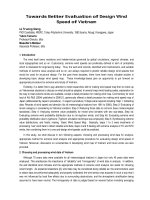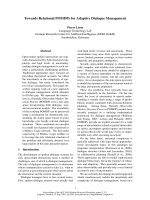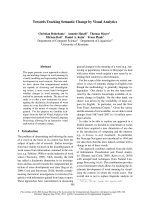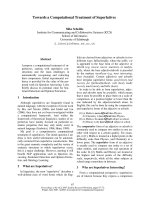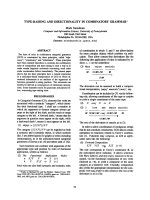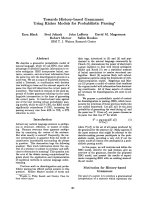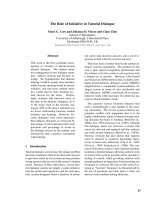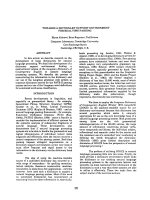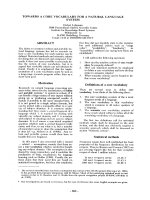Báo cáo khoa học: Towards discovery-driven translational research in breast cancer pdf
Bạn đang xem bản rút gọn của tài liệu. Xem và tải ngay bản đầy đủ của tài liệu tại đây (1.17 MB, 14 trang )
REVIEW ARTICLE
Towards discovery-driven translational research
in breast cancer
Julio E. Celis
1,2
, Jose
´
M. A. Moreira
1,2
, Irina Gromova
1,2
, Teresa Cabezon
1,2
, Ulrik Ralfkiaer
1,2
,
Per Guldberg
1,2
, Per thor Straten
1,2
, Henning Mouridsen
1,3
, Esbern Friis
1,4
, Dorte Holm
1,5
,
Fritz Rank
1,5
and Pavel Gromov
1,2
1 The Danish Centre for Translational Breast Cancer Research, Copenhagen, Denmark
2 Institute of Cancer Biology, Danish Cancer Society, Copenhagen, Denmark
3 Department of Oncology, Copenhagen University Hospital, Denmark
4 Department of Breast and Endocrine Surgery, Copenhagen University Hospital, Denmark
5 Department of Pathology, The Centre of Diagnostic Investigations, Copenhagen University Hospital, Denmark
Introduction
The completion of the human genome project, as well
as the current availability of novel and powerful tech-
nologies within genomics, proteomics and functional
genomics, promise to have a major impact on clinical
practice, as these developments are likely to change
the way in which diseases will be diagnosed, treated
and monitored in the near future. We are moving
increasingly from the study of single molecules to the
analysis of complex biological systems, and one of
the main challenges we face is how best to apply
these powerful technologies to clinically relevant sam-
ples in a well-defined clinical and pathological frame-
work [1–6].
Cancer, being a complex disease that impinges on a
significant proportion of the world population, has
become a prime target for the application of novel
Keywords
breast cancer; proteomics; functional
genomics; signaling pathways; systems
biology; individualised medicine; translational
research
Correspondence
J. E. Celis, The Danish Centre for
Translational Breast Cancer Research and
Institute of Cancer Biology, Danish Cancer
Society, Strandboulevarden 49, DK-2100
Copenhagen, Denmark
Fax: +4535 25 73 76
Tel: +4535 25 73 63
E-mail:
(Received 10 September 2004, revised 29
September 2004, accepted 29 September
2004)
doi:10.1111/j.1432-1033.2004.04418.x
Discovery-driven translational research in breast cancer is moving steadily
from the study of cell lines to the analysis of clinically relevant samples
that, together with the ever increasing number of novel and powerful tech-
nologies available within genomics, proteomics and functional genomics,
promise to have a major impact on the way breast cancer will be diag-
nosed, treated and monitored in the future. Here we present a brief report
on long-term ongoing strategies at the Danish Centre for Translational
Breast Cancer Research to search for markers for early detection and tar-
gets for therapeutic intervention, to identify signalling pathways affected in
individual tumours, as well as to integrate multiplatform ‘omic’ data sets
collected from tissue samples obtained from individual patients. The ulti-
mate goal of this initiative is to coalesce knowledge-based complementary
procedures into a systems biology approach to fight breast cancer.
Abbreviations
FIF, fat interstitial fluid; GSK-3, p-glycogen synthase kinase-3; IHC, immunohistochemistry; IL, interleukin; NIF, nonmalignant interstitial fluid;
TIF, tumour interstitial fluid.
2 FEBS Journal 272 (2005) 2–15 ª 2004 FEBS
technologies – often referred to as the ‘omic’ platforms
– as these may help to identify subgroups of cancer
patients having specific molecular features associated
with clinical outcomes [7–14]. This development is
expected to lead to a predictive, individualized
approach to cancer care, and will facilitate the selection
of treatment modalities that are most likely to benefit
the individual patient. Currently, patient classification
is based on clinical parameters and cellular morphol-
ogy, as well as immunohistochemical analysis using a
restricted number of prognostic ⁄ predictive markers
related to different cell functions such as cell prolifer-
ation, angiogenesis, invasion and metastasis. These
parameters can only classify patients into subgroups
with various prognoses, but it is expected that the com-
bination of known risk factors with new expression and
genomic data will be instrumental to clinicians confron-
ted with treatment options.
At present, we are experiencing a transition in
cancer research as we move from the use of single
‘omic’ platforms to their integrated use to achieve
‘systems biology’ [15]. This integrated approach
should lead to a better understanding of the under-
lying biology of living cells and organisms, resulting
in turn in a more effective translation of basic dis-
coveries into clinical applications [1–5,16]. However,
the implementation of discovery-driven translational
cancer research requires the coordination of basic
research activities, facilities and infrastructures, as
well as the creation of an integrated and multidisci-
plinary environment with the participation of all the
stakeholders in the cancer ordeal, i.e. basic research-
ers, surgeons, oncologists, pathologists, epidemiolo-
gists, patients, patient advocacy groups, funding
agencies and industrial partners. Issues related to
sample collection, handling and storage, standardiza-
tion of protocols, common references, number of
patients, availability of normal controls, access to
bio-banks, tissue arrays, clinical information, follow-
up clinical data, computational and statistical analy-
sis, as well as ethical considerations are critical, and
must be carefully considered and dealt with from the
beginning [1,2,4].
Discovery-driven translational cancer research has
only recently gathered momentum among the basic and
clinical research community, and as a consequence
there are currently few long-term programmes that use
tissue biopsies and bio-fluids as their main sources for
generating multiple data sets [1,2,4,5]. The application
of high throughput technologies to the analysis of tis-
sue biopsies is far more demanding than the analysis of
bio-fluids, due to the heterogeneous nature of the tis-
sues and issues related to sample preparation, as well
as to problems associated with managing long-term
prospective ⁄ retrospective programmes [1,2,5]. Tumours
usually contain malignant cells showing different
degrees of differentiation as well as other cell types,
which together compose the ‘tumour microenviron-
ment’ [17–29]. The cellular heterogeneity problem has
generally been addressed using microdissection tech-
niques that allow the dissection of a defined set of puri-
fied cell populations [30,31]. This technology, however,
cannot solve the problem altogether, as heterogeneity
can be observed even in a small number of cells when
several markers are assessed simultaneously using im-
munohistochemistry. The application of cDNA micro-
array-based expression profiling allows the analysis of
single cells through elegant amplification strategies, and
several studies reporting expression profiles generated
from laser-captured cells have demonstrated the feasi-
bility of the approach [32–34]. Similar single cell analy-
sis of cultured cells using gel-based proteomics [35–37],
on the other hand, does not provide a viable alternative
at the moment, as more sensitive protein detection
methods are needed to identify a significant number of
proteins [38].
Studies of bio-fluids using various proteomic tech-
nologies far exceed those of tissues, as the samples are
easier to collect and handle. One type of analysis in
particular, serum proteomics pattern diagnostic analy-
sis, pioneered by Liotta, Petricoin and coworkers [39],
has shown promise in identifying features that differen-
tiate normal from malignant conditions in ovarian,
prostate and breast cancer [39–42]. This approach uses
a combination of low resolution mass spectra gener-
ated by surface-enhanced laser desorption ionization
time-of-flight (SELDI-TOF) and artificial intelligence-
based informatics algorithms, to search for protein
patterns or features in serum that may detect cancer at
an early stage [39]. Liotta and coworkers have hypo-
thesized that degradation and cleavage of the proteins
that perfuse the tumour microenvironment is a major
source of the peptides that appear in the blood. Once
in the blood circulation, these peptides bind to abun-
dant carrier proteins such as albumin that accumulate
and transport them [43]. Other studies, however, have
highlighted several problems associated with the tech-
nology, particularly related to the fact that the identity
of the peptides included in the serum features is not
known. Also, reproducibility, portability and sample
source have been a matter of concern and much dis-
cussion [44–46]. The use of high resolution mass
spectrometry platforms to collect the data, on the
other hand, is expected to yield superior classification
of serum protein features of a number of cancers in
the near future [47].
J. E. Celis et al. Translational research in breast cancer
FEBS Journal 272 (2005) 2–15 ª 2004 FEBS 3
Breast cancer
Breast cancer is the most common malignancy among
women in the Western world and constitutes 18% of
all cancers in women. In Denmark approximately 3800
women develop breast cancer per year and an estima-
ted 1200 die from the disease. In addition, the number
of registered cases has tripled over the past 40 years,
and breast cancer is now the number one cause of can-
cer mortality in women.
Today, routine mammography, i.e. screening for
breast cancer by X-ray examination, is the only accep-
ted method for early detection of breast cancer and a
recent meta-analysis of seven large-scale studies has
confirmed its value as a screening tool [48]. Although
screening-detected cancers are significantly smaller
than nonscreening ones [49], there is a clear need to
improve the efficiency and sensitivity of the method as
it misses about 10% of the cases and gives a certain
percentage of false positive results. Parameters such as
axillary lymph node status, tumour size, histological
grade and age in combination with predictive factors
such as oestrogen and progesterone receptors are cur-
rently used for selecting the appropriate systemic ther-
apy [50]. The status of immunohistochemistry (IHC) in
diagnostic breast pathology has recently been thor-
oughly reviewed [51]. Although pitfalls associated with
performance and interpretation of IHC results are
plentiful, current routine diagnostic breast pathology is
well equipped to provide modern ‘omics’ research with
important complementary information.
Patients with primary breast cancer are offered sur-
gery, often followed by adjuvant therapeutics, i.e. che-
motherapy, radiotherapy and ⁄ or endocrine therapy.
Despite these treatments, approximately 40% of
patients with lymph node-positive disease will experi-
ence a relapse, and the majority of these patients will
die from disseminated cancer [52,53]. For patients with
lymph node-negative disease, the 5-year recurrence rate
is 25%, suggesting that the risk of recurrence and
subsequent death is closely related to the stage of the
disease at the time of primary surgery. It is reasonable
to assume that the survival rate of breast cancer can
be improved, if the number of patients being diag-
nosed with early stage disease, i.e, node-negative dis-
ease, is increased.
Chemotherapy and ⁄ or endocrine therapy is offered
to patients at low, moderate and high risk of recur-
rence and death, i.e. to a prognostically heterogeneous
group of patients with a range of risk from a few per-
cent up to 80%. This group, which constitutes about
70% of all new breast cancer patients [54], is charac-
terized according to the following classical prognostic
factors: nodal status (positive); size of the primary
tumour (‡ 20 mm); malignancy grade (2–3) and steroid
receptor status (negative). With adjuvant systemic ther-
apy being offered to this patient group, 30–40% of the
expected deaths can be avoided. However, in absolute
terms, the mortality reduction amounts to only a few
percent (i.e. from 5 to 3%) in the low risk group, and
to 25% in the high risk group (i.e. from 80% to
60%). Thus, although adjuvant systemic therapy has
led to a considerable improvement of the prognosis of
the breast cancer population, it also carries the signifi-
cant adverse effect of overtreatment [55].
It is well known from the treatment of advanced
breast cancer that patients nonresponsive to one speci-
fic type of therapy may react to another type, indica-
ting that the response to a specific treatment relates
to specific characteristics (predictive factors) of the
tumour. Thus, there is a need to develop new inde-
pendent prognostic and predictive indicators in pri-
mary breast cancer to improve patient selection for
specific and individual treatments. Moreover, it is
important to develop new diagnostic methods to detect
breast cancer at a very early stage, as early detection
increases survival rate. Today, many cancers are detec-
ted late, when spreading to the surrounding tissue and
metastases has taken place.
The Danish Centre for Translational Breast
Cancer Research
Responding to the above challenges, the Danish Can-
cer Society catalysed in 2002 the creation of a multidis-
ciplinary, multi-centre research environment, The
Danish Centre for Translational Breast Cancer
Research (DCTB), to fight breast cancer. DCTB hosts
scientists working in various areas of preclinical cancer
research (cell cycle control, invasion and microenvi-
ronmental alterations, apoptosis, cell signalling and
immunology) with clinicians (surgeons, oncologists),
pathologists and epidemiologists in an integrated, mis-
sion-oriented discovery-driven translational research
environment. The DCTB places the patient at the cen-
tre and the ultimate goal is to conduct research to
improve survival and quality of life of breast cancer
patients.
The underlying concept behind this long-term, con-
certed approach is the use of multiple experimental
paradigms from genomics, proteomics and functional
genomics, to the prospective analysis of clinically rele-
vant fresh samples obtained from the same patient,
along with the systematic integration of the biological
and clinical data sets [2,4]. The aim of this systematic
knowledge-based approach is (a) to understand the
Translational research in breast cancer J. E. Celis et al.
4 FEBS Journal 272 (2005) 2–15 ª 2004 FEBS
molecular mechanisms underlying disease pathogenesis,
(b) facilitate early detection and prognosis, and (c) to
provide novel targets for therapeutic intervention. For
retrospective studies, the Centre efforts are supported
by the Danish Breast Cancer Cooperative Group
(DBCG), a group that manages a tumour repository
bank containing frozen tissue samples from approxi-
mately 10 000 breast cancer patients with clinical fol-
low-up of up to 10 years. In due course, the DBCG is
expected to facilitate the implementation of therapeutic
modalities on a nationwide basis.
Below we give a brief account of our long-term
strategies on ongoing long-term strategies within
DCTB to search for markers for early detection and
targets for therapeutic intervention, identify signalling
pathways affected in individual tumours, as well as to
integrate multiplatform ‘omic’ data sets collected from
tissue samples obtained from individual patients.
Biomarkers for early detection and
targets for therapeutic intervention
Biomarkers for early detection
Success in detecting markers for early breast cancer
detection depends very much on the sources that are
used to conduct the search. To date, two strategies
have been used to search for these biomarkers. One is
based on the comparative analysis of the proteome of
peripheral fluids, and the other on similar analysis of
diseased tissues. Even though appealing, the first
approach suffers from the drawback that markers are
likely to be present in lower amounts in the blood cir-
culation and, as a result, may be difficult to detect.
Diseased tissues on the other hand may express the
markers at relatively higher levels, but it is not an easy
task to identify those that ultimately will appear in the
blood circulation. The use of nipple-aspirated fluid as
a source of biomarkers has been explored in a few
cases, but no systematic studies have been reported so
far [56,57].
Our group has recently devised an alternative
approach that is based on the analysis of near fluids,
as these may be enriched in externalized biomarkers
and may justify a systematic long-term search [4,58].
Compelling evidence indicates that tumour growth
and progression is dependent on the malignant poten-
tial of the tumour cells as well as on the multidirec-
tional interactions of local factors produced by all
the cell types – tumour, stroma and endothelial cells,
in addition to immune and inflammatory cells – pre-
sent in the local microenvironment [17–29]. All these
cells secrete, shed or release proteins to the interstitial
fluid that bathes the tumour microenvironment and
some of these proteins, including biomarkers, may
eventually reach the blood circulation through the
lymphatic vascular system. This ‘near fluid’, the
tumour interstitial fluid (TIF) [58], may provide a
rich source of biomarkers for early detection as well
as novel targets for therapeutic intervention as its
protein composition can be readily compared with its
nonmalignant counterpart (NIF) using proteomic
technologies. Figure 1 illustrates the steps we have
undertaken to retrieve this fluid from fresh tumour
biopsies, nonmalignant tissue, axillary nodal metasta-
sis (MIF), and fat interstitial fluid (FIF) obtained
immediately following surgery. So far, we have ana-
lyzed the protein composition of TIFs recovered from
30 high-risk patients. The criteria for high-risk cancer
applied by DBCG are age below 35 years old, and ⁄ or
tumour diameter of more than 20 mm, and ⁄ or histo-
logical malignancy 2 or 3, and ⁄ or negative oestrogen
and progesterone receptor status and ⁄ or positive axil-
lary status. Figure 2A shows a two-dimensional iso-
electrofocusing (IEF) gel of a representative fluid.
The protein composition of the TIF is strikingly dif-
ferent to that of serum, although both fluids share
some of their major components (Fig. 2B). The TIF
is highly enriched in proteins that are either secreted
via the classical endoplasmic reticulum (ER) ⁄ Golgi
pathway, shed by membrane vesicles (membrane
blebbing), or externalized by plasma membrane trans-
porter ([59] and references therein). Quantitation of
the ratio of thioredoxin (externalized by an ER ⁄ Golgi
independent route) ⁄ cytokeratin 18 (CK18) in whole
tumour lysates and its corresponding TIF, yielded
values that differ by a factor of 10 or more (data
not shown), suggesting that nonspecific protein
release due to cell death is not a major contributor
to TIF.
So far, 284 primary translation products, as well as
hundreds of post-translational modifications, have
been identified using a combination of procedures that
include mass spectrometry, 2D gel immunoblotting
and cytokine-specific antibody arrays (RayBiotech,
Atlanta, GA, USA) [4,58]. Cellular function categories
assigned to the known proteins include – but are not
limited to – ion transport, cell motility, transporter
activity, protein transport, signal transduction,
response to oxidative stress, immune response, energy
pathways, regulation of gene expression, proteolytic
pathways, protein metabolism, maintainers of cytoske-
leton organization, cell–cell signalling, regulation of
cell–cell communication and regulation of cell growth
[58]. A protein database will soon be available through
our web site ().
J. E. Celis et al. Translational research in breast cancer
FEBS Journal 272 (2005) 2–15 ª 2004 FEBS 5
A systematic search for potential biomarkers starts
by comparing the protein profiles of nonmalignant
(NIF) and tumour (TIF) fluids, and the identification
of proteins that are highly deregulated in the latter
(Fig. 2C,D). This is a long-term endeavour that will
require the qualitative and quantitative comparison of
hundreds of sample pairs using gel-based proteomics,
the preparation of specific antibodies against putative
markers for validation, as well as the analysis of the
corresponding serum ⁄ plasma and other control sam-
ples for the presence of these markers.
As the above approach mainly detects proteins pre-
sent at moderate to high levels and is set on a discov-
ery mode, we are establishing in parallel more sensitive
antibody microarray platforms to detect known, lesser
abundant components that may be potential biomark-
ers themselves. For example, elevated levels of interleu-
kin (IL)-6 have been observed in the serum of patients
with breast cancer [60], and the levels of this cytokine
have been shown to predict the survival of patients
with metastatic breast cancer [61]. These observations
prompted us to assess the levels of IL-6 both in NIF
and TIF. Figure 3A shows cytokine-specific antibody
arrays (120 cytokines; RayBiotech) reacted with NIF
and TIF proteins retrieved from the same patient.
Increased levels of several cytokines, including IL-6
were observed in the TIF, and some of these changes
could be independently confirmed using the Bio-Plex
system from Bio-Rad (Hercules, CA, USA) which can
quantitatively measure 17 human cytokines simulta-
neously (Fig. 3B). Clearly, there is a good correlation
between the levels of IL-6 as determined by the two
platform technologies, a fact that was further validated
by performing IHC on nonmalignant and tumour tis-
sues using an IL-6 specific antibody known to work
with paraffin-embedded sections. As exemplified in
Fig. 4B, the tumour tissue stains strongly with the
antibody as compared to its nonmalignant tissue coun-
terpart (Fig. 4A, patient 46), indicating that indeed the
elevated levels of IL-6 observed in TIF are in part due
to the production of this cytokine by the tumour cells.
The high levels of IL-6 observed in the sera of cancer
patients, however, may not only reflect production of
this cytokine by tumour cells, as fat tissue (Fig. 4C) –
which is very abundant in the mamma (Fig. 1) – pro-
duces significant levels of IL-6 as judged by antibody
array analysis of FIF (Fig. 4D). The bona fide origin
of FIF is supported by the presence of leptin, a protein
known to be produced by adipose tissue (Fig. 4D).
Whether IL-6 produced by fat cells reaches the blood
circulation is at present unknown [62–65], but this pos-
sibility must be taken into consideration when search-
ing for specific biomarkers. This example illustrates the
difficulties one faces in biomarker discovery, and
underscores how careful one must be when interpreting
data generated from complex samples.
Targets for therapeutic intervention – towards
identifying and building up pathways affected
in breast tumours
The goal of individualized treatment is to provide ther-
apies to which the patients may best respond. This will
require a thorough understanding of the molecular
mechanism underlying the particular phenotype in
order to identify potential therapeutic agents with a
Fig. 1. Recovering the TIF from fresh breast tumours. Fresh tissue (about 0.25 g) washed twice in phosphate buffered saline (NaCl ⁄ P
i
), is
cut in small pieces of about 1–3 mm
3
and placed in a 10-mL conical plastic tube containing 0.8–1 mL of NaCl ⁄ P
i
. Samples are then incuba-
ted for 1 h at 37 °C in a humidified CO
2
incubator. Following incubation the samples are centrifuged at 300 g, at room temperature for
1 min and the supernatant is aspirated with the aid of an elongated Pasteur pipette. Samples are then further centrifuged at 4000 g,at4°C
in a refrigerated centrifuge. Aliquots for gel analysis are freeze dried while the rest is kept at )80 °C until further use.
Translational research in breast cancer J. E. Celis et al.
6 FEBS Journal 272 (2005) 2–15 ª 2004 FEBS
high degree of specificity. Key biological processes that
harbour potential targets for intervention include cell
proliferation, apoptosis, invasion and metastasis,
angiogenesis and genomic instability [66]. Today, tar-
geted therapies are aimed mainly at growth factor sig-
nalling pathways, and tyrosine-kinase receptors such
as Her2 ⁄ neu and epidermal growth factor receptor
(EGFR). Antibodies and rationally designed small-
molecule drugs developed to target specific molecules
involved in key processes of tumour progression
such as Herceptin (trastuzumab), Erbitux (IMC-
C225, cetuximab), Tarceva (erlotinib HCP), Avastin
(bevacizumab), Gleevec (imatinib mesylate), and Iressa
(gefitinib) are currently in clinical trials. Based on
results obtained in preclinical studies with animal mod-
els, which showed that systemic administration of
growth factor inhibitors could restrain the growth and
metastatic potential of human TCC xenografts [67],
and the promising results obtained with EGFR inhibi-
tors in other tumour types, several trials are now
ongoing to test these agents, alone or in combination,
in patients with various cancers [68].
The potential therapeutic applications of proteins
present in the TIF is clear as this fluid contains many
AB
CD
Fig. 2. Protein profiling of interstitial fluids. Isoelectrofocusing (IEF) 2D gels of proteins from (A) TIF 41, (B) serum, (C) NIF 46 and (D) TIF 46.
J. E. Celis et al. Translational research in breast cancer
FEBS Journal 272 (2005) 2–15 ª 2004 FEBS 7
growth factorsÒ and signalling molecules (Fig. 3A)
[58], and it is probable that many additional interest-
ing novel proteins involved in the regulation of the
tumour ecosystem may be found, in particular using
shotgun proteomics [69] and references therein. The
TIF can be recovered from tissues using nondenatur-
ing conditions, and as such it can be readily analyzed
using protein biochip technologies that provide
resourceful tools for target identification and valid-
ation, as well as for studying protein interactions
(enzyme substrates, drugs, lipids, etc.). In particular,
antibody-based arrays can detect protein phosphoryla-
tion as a means to assess the function of a given sig-
nalling pathway [70,71]. Phosphorylation is a key
regulatory factor in many aspects of cell proliferation,
and as a result the phosphorylation status of novel
proteins is eagerly being pursued using mass spectro-
metry [72–74].
In an effort to identify signalling pathways affec-
ted in individual breast tumours and to focus our
search for potential targets for intervention, we have
started comprehensive IHC analysis of tumours using
phospho-specific antibodies against key signalling
molecules [75]. In parallel, these studies are being
complemented using reverse tissue lysate arrays
[76,77] in collaboration with Zeptosens (Zeptosens
AG, Witterswil, Switzerland). In the long run, these
studies are expected to provide a framework in
which to integrate data on known signalling mole-
cules, as well as on forthcoming ‘omics’ information
generated from the same tumours (see below). As an
example, Fig. 5 shows IHCs of two breast tumours
probed with antibodies against p53 (Fig. 5A,D),
p-p53 (Fig. 5B,E) and p-glycogen synthase kinase-3
(GSK-3; Fig. 5C,F), a serine ⁄ threonine kinase
involved in various pathways including the
A
B
Fig. 3. IL-6 levels in NIF and TIF. (A) Cyto-
kine-specific antibody arrays (RayBioÒ
human cytokine array series 1000) were
incubated with 0.5 mL of NIF and TIF accor-
ding to manufacturer’s instructions. (B)
Quantification of cytokines using the
BioPlex system (Bio-Rad).
Translational research in breast cancer J. E. Celis et al.
8 FEBS Journal 272 (2005) 2–15 ª 2004 FEBS
AB
C
D
Fig. 4. IHC of nonmalignant epithelial cells
(A) and tumour cells (B) from patient 46 usi-
ng IL-6 antibodies. (C) Haematoxylin and
eosin staining of fat tissue located far from
a tumour. (D) Cytokine-specific antibody
array (RayBioÒ) incubated with FIF as
described in Fig. 3.
AB C
DE
F
Fig. 5. Aberrant Wnt ⁄ b-catenin pathway in tumour 14. (A–F) immunohistochemistry of paraffin sections of tumours 14 and 7 incubated with
antibodies against p53 (A and D), phosphorylated p53 (p-p53, serine 15) (B and E) and phosphorylated GSKb (p-GSKb, C and F).
J. E. Celis et al. Translational research in breast cancer
FEBS Journal 272 (2005) 2–15 ª 2004 FEBS 9
Wnt ⁄ b-catenin signalling cascade [78–80]. The latter
plays an important role in development by augment-
ing the signalling activity of b-catenin, a structural
component of the cell-cell adhesions that is known
to be deregulated in various cancers, including breast
cancer [81–85]. Both p53 and GSK-3b have been
implicated in regulating the levels of b-catenin [86].
As shown in Fig. 5A, tumour 14 depicts activation
of p53 in a region of the lesion in which GSK-3b is
also activated (Fig. 5C), while the other tumour does
not. When activated, GSK-3b phosphorylates (tyro-
sine phosphorylation) b-catenin, a fact that precludes
its binding to a-catenin and E-cadherin, thus pre-
venting cell adhesion and facilitating spreading.
Phosphorylation of b-catenin targets it for degrada-
tion by the proteasome [87], and the p53 activation
is known to feed back and down-regulates b-catenin
synthesis [86].
The presence in tumours of known signalling mole-
cules involved in various pathways is being performed
using antibody specific arrays (PanoramaÒ antibody
microarray) that contain probes against hundreds of
signalling molecules. Arrays are incubated with pro-
teins extracted from tumours using low concentrations
of Triton X-100 yielding semiquantitative data for
many proteins simultaneously. Figure 6 shows a rep-
resentative protein antibody array analysis of a
tumour. In addition, quantitative gel-based proteomic
(Fig. 7) and transcriptomic data are being generated
from the same tumour samples in selected cases in an
effort to identify groups of coregulated proteins and
mRNAs that may provide an integrated view of
Fig. 6. Detection of signalling molecules in tumours using the PanoramaÒ antibody array (Sigma-Aldrich). Fresh tumours were minced and
homogenized at room temperature with 0.1% Triton in phosphate buffered saline (NaCl ⁄ P
i
). Samples were centrifuged at 300 g, at room tem-
perature for 1 min and the supernatant was aspirated with the aid of an elongated Pasteur pipette. The supernatant was then further centrifuged
at 4000 g,at4°C in a refrigerated centrifuge. Aliquots for gel analysis were freeze dried while the rest is kept at )80 °C until further use.
Translational research in breast cancer J. E. Celis et al.
10 FEBS Journal 272 (2005) 2–15 ª 2004 FEBS
signalling cascades, extend the number of possible tar-
get candidates, as well as provide a more detailed
molecular phenotype of the tumour based on multiple
parameters.
Future directions/conclusions
The analysis of tumour samples using single ‘omic’
platform technologies such as microarrays has exempli-
fied the value of this technology to classify tumours as
well as to derive signatures for prognosis and response
to treatment, particularly in lymphomas [7,8,88], leuk-
aemia [89,90] and breast cancer [12–14,91,92]. Today,
however, it is becoming increasingly clear that we must
use multiplatform technologies to classify subgroups of
patients for more precise and predictive, individualized
approaches to cancer treatment [93]. These efforts must
be accompanied by the development of bioinformatics
tools for integrating and mining the data as well as by
systematic, knowledge-based long-term approaches that
are supported by proper clinical infrastructures.
There are several issues, however, that must be care-
fully and promptly addressed if we are going to fulfil
the dream of bringing individualized cancer care closer
to reality. First of all, we must acknowledge the value
of long-term research and provide the appropriate
legal and ethical framework to encourage the collabor-
ation among all the stakeholders in the cancer ordeal.
Bridging the gap between basic and clinical research,
facilitating the engagement of the industry, creating
new infrastructures and bio banks, as well as the cre-
ation of innovative clinical trials are among the items
that require urgent action. The aim of cancer research
is to improve the life expectancy and quality of life of
patients and we must make every effort to coordinate
current activities in order to achieve this goal.
Acknowledgements
We would like to thank Gitte Lindberg Stort, Dorrit
Lu
¨
tzhøft, Hanne Nors, Michael Radich Johansen,
Britt Olesen and Signe Trentemøller for expert
Fig. 7. Quantitative gel-based proteomics. Twenty tumour cryo-sections (8 microns) were dissolved in 100 lL of Zeptosens lysis solution
and 40 lL were applied to the first dimension isoelectrofocusing gel. The first section of each tumour is routinely kept for histology analysis
in order to facilitate the interpretation of the data.
J. E. Celis et al. Translational research in breast cancer
FEBS Journal 272 (2005) 2–15 ª 2004 FEBS 11
technical assistance. We also like to thank Camilla
Lauritzen for helpful discussion. This work was sup-
ported by the Danish Cancer Society through the bud-
get of the Institute of Cancer Biology and by grants
from the Danish Medical Research Council, the Nat-
ural and Medical Sciences Committee of the Danish
Cancer Society, and the John and Birthe Meyer Foun-
dation. The support from the Marketing Department
at the Danish Cancer Society is also greatly appreci-
ated. We would also like to acknowledge the support
and collaboration with Bio-Rad and Zeptosens.
References
1 Celis JE & Gromov P (2003) Proteomics in translational
cancer research: Towards an integrated approach. Can-
cer Cell 3, 9–15.
2 Celis JE, Gromov P, Gromova IJM, Moreira JM, Cabe-
zon T, Ambartsumian N, Grigorian M, Lukanidin E,
thor Straten P, Guldberg P et al. (2003) Integrating pro-
teomic and functional genomic technologies in discov-
ery-driven, translational breast cancer research. Mol
Cell Proteomics 2, 2369–377.
3 Johann DJ Jr, McGuigan MD, Patel AR, Tomov S,
Ross S, Conrads TP, Veenstra TD, Fishman DA,
Whiteley GR & Petricoin EF III & Liotta, LA (2004)
Clinical proteomics and biomarker discovery. Ann NY
Acad Sci 1022, 295–305.
4 Celis JE, Gromova I, Moreira JM, Cabezon T &
Gromov P (2004) Impact of proteomics on bladder
cancer research. Pharmacogenomics 5, 381–394.
5 Hanash S (2004) Integrated global profiling of cancer.
Nat Rev Cancer 4, 638–644.
6 Fung ET (2004) Strategies in clinical proteomics: from
discovery to assay. Preclinica 2, 253–258.
7 Alizadeh AA, Eisen MB, Davis RE, Ma C, Lossos IS,
Rosenwald A, Boldrick JC, Sabet H, Tran T, Yu X
et al. (2000) Distinct types of diffuse large B-cell lym-
phoma identified by gene expression profiling. Nature
403, 503–511.
8 Shipp MA, Ross KN, Tamayo P, Weng AP, Kutok JL,
Aguiar RC, Gaasenbeek M, Angelo M, Reich M,
Pinkus GS, et al. (2002) Diffuse large B-cell lymphoma
outcome prediction by gene-expression profiling and
supervised machine learning. Nat Med 8, 68–74.
9 Gordon GJ, Jensen RV, Hsiao LL, Gullans SR,
Blumenstock JE, Richards WG, Jaklitsch MT, Sugar-
baker DJ & Bueno R. (2003) Using gene expression
ratios to predict outcome among patients with mesothe-
lioma. J Natl Cancer Inst 95, 598–605.
10 Dyrskjot L, Thykjaer T, Kruhoffer M, Jensen JL,
Marcussen N, Hamilton-Dutoit S, Wolf H & Orntoft
TF (2003) Identifying distinct classes of bladder carci-
noma using microarrays. Nat Genet 33, 90–96.
11 Greiner TC (2004) mRNA microarray analysis in
lymphoma and leukemia. Cancer Treat Res 121, 1–12.
12 Sotiriou C, Neo SY, McShane LM, Korn EL,
Long PM, Jazaeri A, Martiat P, Fox SB, Harris AL &
Liu ET (2003) Breast cancer classification and prognosis
based on gene expression profiles from a population-
based study. Proc Natl Acad Sci USA 100, 10393–
10398.
13 Huang E, Cheng SH, Dressman H, Pittman J,
Tsou MH, Horng CF, Bild A, Iversen ES, Liao M,
Chen CM, et al. (2003) Gene expression predictors of
breast cancer outcomes. Lancet 361, 1590–1596.
14 Cleator S & Ashworth A (2004) Molecular profiling of
breast cancer: clinical implications. Br J Cancer 90,
1120–1124.
15 Johnson PC & Higgins AJ (2004) Pricise phenotyping
anchoring for drug target identification, validation
and biomarker discovery using an advanced systems
biology approach. Drug Discovery World Summer, 55–
62.
16 Hanash SM & Beretta LM (2002) Operomics: integrated
genomic and proteomic profiling of cells and tissues.
Brief Funct. Genomic Proteomic 1, 10–22.
17 Liotta LA & Kohn EC (2001) The microenvironment of
the tumour–host interface. Nature 411, 375–379.
18 Bissell MJ & Radisky D (2001) Putting tumours in con-
text. Nat Rev Cancer 1, 46–54.
19 Coussens LM & Werb Z (2001) Inflammatory cells and
cancer: think different! J Exp Med 193, F23–F26.
20 Coussens LM & Werb Z (2002) Inflammation and can-
cer. Nature 420, 860–867.
21 Leek RD & Harris AL (2002) Tumor-associated macro-
phages in breast cancer. J Mammary Gland Biol Neopla-
sia 7, 177–189.
22 Ahmad SA, Jung YD, Liu W, Reinmuth N, Parikh A,
Stoeltzing O, Fan F & Ellis LM (2002) The role of the
microenvironment and intracellular cross-talk in tumor
angiogenesis. Semin Cancer Biol 12, 105–112.
23 Quaranta V & Giannelli G (2003) Cancer invasion:
watch your neighbourhood! Tumori 89, 343–348.
24 van Kempen LC, Ruiter DJ, van Muijen GN & Cous-
sens LM (2003) The tumor microenvironment: a critical
determinant of neoplastic evolution. Eur J Cell Biol 82,
539–548.
25 Cairns RA, Khokha R. & Hill RP (2003) Molecular
mechanisms of tumor invasion and metastasis: an inte-
grated view. Curr Mol Med 3, 659–671.
26 Haslam SZ & Woodward TL (2003) Host microenviron-
ment in breast cancer development: epithelial-cell–stro-
mal–cell interactions and steroid hormone action in
normal and cancerous mammary gland. Breast Cancer
Res 5, 208–215.
27 Henning T, Kraus M, Brischwein M, Otto AM &
Wolf B (2004) Relevance of tumor microenvironment
Translational research in breast cancer J. E. Celis et al.
12 FEBS Journal 272 (2005) 2–15 ª 2004 FEBS
for progression, therapy and drug development. Antic-
ancer Drugs 15, 7–14.
28 Radisky DC & Bissell MJ (2004) Cancer. Respect thy
neighbor! Science 303, 775–777.
29 Allinen M, Beroukhim R, Cai L, Brennan C, Lahti-
Domenici J, Huang H, Porter D, Hu M, Chin L,
Richardson A, et al. (2004) Molecular characterization
of the tumor microenvironment in breast cancer. Cancer
Cell 6, 17–32.
30 Celis JE & Bravo R. (1984) Two-Dimensional Gel
Electrophoresis of Proteins: Methods and Applications.
Academic Press, New York.
31 Emmert-Buck MR, Bonner RF, Smith PD, Chuaqui RF,
Zhuang Z, Goldstein SR, Weiss RA & Liotta LA (1996)
Laser capture microdissection. Science 274, 998–1001.
32 Kamme F & Erlander MG (2003) Global gene expres-
sion analysis of single cells. Curr Opin Drug Discov
Devel 6, 231–236.
33 Kamme F, Zhu J, Luo L, Yu J, Tran DT, Meurers B,
Bittner A, Westlund K, Carlton S & Wan J (2004)
Single-cell laser-capture microdissection and RNA
amplification. Methods Mol Med 99, 215–223.
34 Glanzer JG & Eberwine JH (2004) Expression profiling
of small cellular samples in cancer: less is more. Br J
Cancer 90, 1111–1114.
35 Bravo R, Fey SJ, Small JV, Larsen PM & Celis JE
(1981) Coexistence of three major isoactins in a single
sarcoma 180 cell. Cell 25, 195–202.
36 Hu S, Le Z, Newitt R, Aebersold R, Kraly JR, Jones
M & Dovichi NJ (2003) Identification of proteins in sin-
gle-cell capillary electrophoresis fingerprints based on
comigration with standard proteins. Anal Chem 75,
3502–3505.
37 Hu S, Michels DA, Fazal MA, Ratisoontorn C,
Cunningham ML & Dovichi NJ (2004) Capillary sieving
electrophoresis ⁄ micellar electrokinetic capillary chroma-
tography for two-dimensional protein fingerprinting of
single mammalian cells. Anal Chem 76, 4044–4049.
38 Lilley KS, Razzaq A & Dupree P (2002) Two-dimen-
sional gel electrophoresis: recent advances in sample
preparation, detection and quantitation. Curr Opin
Chem Biol 6, 46–50.
39 Petricoin EF, Ardekani AM, Hitt BA, Levine PJ,
Fusaro VA, Steinberg SM, Mills GB, Simone C,
Fishman DA, Kohn EC & Liotta LA (2002) Use of
proteomic patterns in serum to identify ovarian cancer.
Lancet 359, 572–577.
40 Petricoin EF III, Ornstein, DK, Paweletz, CP, Ardekan-
i, A, Hackett, PS, Hitt, BA, Velassco, A, Trucco, C, Wi-
egand, L, Wood, K et al. (2002) Serum proteomic
patterns for detection of prostate cancer. J Natl Cancer
Inst 94 , 1576–1578.
41 Petricoin EE, Paweletz CP & Liotta LA (2002) Clinical
applications of proteomics: proteomic pattern diagnos-
tics. J Mammary Gland Biol Neoplasia 7, 433–440.
42 Petricoin EF, Ornstein DK & Liotta LA (2004) Clinical
proteomics: Applications for prostate cancer biomarker
discovery and detection. Urol Oncol 22, 322–328.
43 Mehta AI, Ross S, Lowenthal MS, Fusaro V, Fishman
DA & Petricoin EF (2003–04) 3rd & Liotta L.A. Bio-
marker amplification by serum carrier protein binding.
Dis Markers 19, 1–10.
44 Diamandis EP (2004) Mass spectrometry as a diagnostic
and a cancer biomarker discovery tool. Opportunities
and potential limitations. Mol Cell Proteomics 3, 367–
378.
45 Diamandis EP (2004) Proteomic patterns to identify
ovarian cancer: 3 years on. Expert Rev Mol Diagn 4,
575–577.
46 Garber K (2004) New gene discoveries may boost DNA
stool testing for colorectal cancer. J Natl Cancer Inst
96, 820–821.
47 Zhang Z, Bast RC Jr, Yu Y, Li J, Sokoll LJ, Rai AJ,
Rosenzweig JM, Cameron B, Wang YY, Meng XY
et al. (2004) Three biomarkers identified from serum
proteomic analysis for the detection of early stage ovar-
ian cancer. Cancer Res 64, 5882–5890.
48 Nystrom L, Andersson I, Bjurstam N, Frisell J,
Nordenskjold B & Rutqvist LE (2002) Long-term
effects of mammography screening: updated overview of
the Swedish randomised trials. Lancet 359, 909–919.
49 Tange UB, Jensen MB, Vejborgr IMM, Rank FE,
Blichert-Toft M, Mouridsen HT & Lynge E (2002)
Clinical impact of introduction of mammography
screening in a non-screening country. Scand J Surg 91,
293–303.
50 Goldhirsch A, Wood WC, Gelber RD, Coates AS,
Thurlimann B & Senn HJ (2003) Meetings highlights:
Updated international expert consensus on the primary
therapy of early breast cancer. J Clin Oncol 21, 1–8.
51 Lerwill MF (2004) Current practical applications of
diagnostic immunohistochemistry in breast pathology.
Am J Surg Pathol 28, 1076–1091.
52 Early Breast Cancer Trialists’ Collaborative Group.
(1998) Tamoxifen for early breast cancer: an overview
of the randomised trials. Lancet 351, 1451–1467.
53 Early Breast Cancer Trialists’ Collaborative Group.
(1998) Polychemotherapy for early breast cancer: an
overview of the randomised trials. Lancet 352, 930–942.
54 Mouridsen HT & Brunner N (2004) Clinical infrastruc-
tures to support proteomic studies of tissue and fluids in
breast cancer. Mol Cell Proteomics 3, 302–310.
55 Bergh J & Holmquist M (2001) Who should not receive
adjuvant chemotherapy? International databases. J Natl
Cancer Inst Monogr 30, 103–108.
56 Paweletz CP, Trock B, Pennanen M, Tsangaris T, Mag-
nant C, Liotta LA & Petricoin EF III (2001) Proteomic
patterns of nipple aspirate fluids obtained by SELDI-
TOF: potential for new biomarkers to aid in the diagno-
sis of breast cancer. Dis Markers 17, 301–307.
J. E. Celis et al. Translational research in breast cancer
FEBS Journal 272 (2005) 2–15 ª 2004 FEBS 13
57 Varnum SM, Covington CC, Woodbury RL, Petritis K,
Kangas LJ, Abdullah MS, Pounds JG, Smith RD &
Zangar RC (2003) Proteomic characterization of nipple
aspirate fluid: identification of potential biomarkers of
breast cancer. Breast Cancer Res Treat 80, 87–97.
58 Celis JE, Gromov P, Cabezon T, Moreira JM, Ambar-
tsumian N, Sandelin K, Rank F & Gromova I (2004)
Proteomic characterization of the interstitial fluid per-
fusing the breast tumor microenvironment: a novel
resource for biomarker and therapeutic target discovery.
Mol Cell Proteomics 3, 327–344.
59 Nickel W (2003) The mystery of nonclassical protein
secretion. A current view on cargo proteins and poten-
tial export routes. Eur J Biochem 270, 2109–2119.
60 Kozlowski L, Zakrzewska I, Tokajuk P & Wojtukiewicz
MZ (2003) Concentration of interleukin-6 (IL-6), inter-
leukin-8 (IL-8) and interleukin-10 (IL-10) in blood
serum of breast cancer patients. Rocz Akad Med Bia-
lymst 48, 82–84.
61 Salgado R, Junius S, Benoy I, Van Dam P,
Vermeulen P, Van Marck E, Huget P & Dirix LY
(2003) Circulating interleukin-6 predicts survival in
patients with metastatic breast cancer. Int J Cancer
103, 642–646.
62 Bray GA (2004) Medical consequences of obesity. J Clin
Endocrinol Metab 89, 2583–2589.
63 Wallenius K, Jansson JO & Wallenius V (2003) The
therapeutic potential of interleukin-6 in treating obesity.
Expert Opin Biol Ther 3, 1061–1070.
64 Kern PA, Ranganathan S, Li C, Wood L & Ranga-
nathan G (2001) Adipose tissue tumor necrosis factor
and interleukin-6 expression in human obesity and insu-
lin resistance. Am J Physiol Endocrinol Metab 280,
E745–E751.
65 Cancello R, Tounian A, Poitou, Ch & Clement, K
(2004) Adiposity signals, genetic and body weight regu-
lation in humans. Diabetes Metab 30, 215–227.
66 Hanahan D & Weinberg RA (2000) The hallmarks of
cancer. Cell 100, 57–70.
67 Dinney CP, Parker C & Dong Z (1997) Therapy
of human transitional cell carcinoma of the bladder
by oral administration of the epidermal growth factor
receptor protein tyrosine kinase inhibitor 4,5-dianili-
nophthalimide. Clin Cancer Res 3, 161–168.
68 Bellmunt J, Hussain M & Dinney CP (2003) Novel
approaches with targeted therapies in bladder cancer.
Therapy of bladder cancer by blockade of the epidermal
growth factor receptor family. Crit Rev Oncol Hematol
46, S85–S104.
69 Aebersold R & Mann M (2003) Mass spectrometry-
based proteomics. Nature 422, 198–207.
70 Bichsel VE, Liotta LA & Petricoin EF III (2001) Cancer
proteomics: from biomarker discovery to signal pathway
profiling. Cancer J 7, 69–78.
71 Knezevic V, Leethanakul C & Bichsel VE (2001) Pro-
teomic profiling of the cancer microenvironment by
antibody arrays. Proteomics 1, 1271–1278.
72 Hinsby AM, Olsen JV & Mann M (2004) Tyrosine
phosphoproteomics of FGF signaling – a role for insu-
lin receptor substrate-4. J Biol Chem 279, 46438–46447.
73 Nuhse TS, Stensballe A, Jensen ON & Peck SC (2003)
Large-scale analysis of in vivo phosphorylated mem-
brane proteins by immobilized metal ion affinity chro-
matography and mass spectrometry. Mol Cell
Proteomics 2, 1234–1243.
74 Schulenberg B, Goodman TN, Aggeler R, Capaldi RA
& Patton WF (2004) Characterization of dynamic and
steady-state protein phosphorylation using a fluorescent
phosphoprotein gel stain and mass spectrometry. Elec-
trophoresis 25, 2526–2532.
75 Paweletz CP, Charboneau L, Bichsel VE, Simone NL,
Chen T, Gillespie JW, Emmert-Buck MR, Roth MJ,
Petricoin EF III & Liotta LA (2001) Reverse phase pro-
tein microarrays which capture disease progression show
activation of pro-survival pathways at the cancer inva-
sion front. Oncogene 20, 1981–1989.
76 Wulfkuhle JD, Aquino JA, Calvert VS, Fishman DA,
Coukos G, Liotta LA & Petricoin EF III (2003) Signal
pathway profiling of ovarian cancer from human tissue
specimens using reverse-phase protein microarrays. Pro-
teomics 3, 2085–2090.
77 Nishizuka S, Charboneau L, Young L, Major S, Rein-
hold WC, Waltham M, Kouros-Mehr H, Bussey KJ,
Lee JK, Espina V et al. (2003) Proteomic profiling of
the NCI-60 cancer cell lines using new high-density
reverse-phase lysate microarrays. Proc Natl Acad Sci
USA 100, 14229–14234.
78 Novak A & Dedhar S (1999) Signaling through beta-
catenin and Lef ⁄ Tcf. Cell Mol Life Sci 56, 523–537.
79 Doble BW & Woodgett JR (2003) GSK-3: tricks of the
trade for a multi-tasking kinase. J Cell Sci 116, 1175–
1186.
80 Green JB (2004) Lkb1 and GSK3-beta kinases at the
center and poles of the action. Cell Cycle 3, 12–14.
81 Bienz M & Clevers H (2000) Linking colorectal cancer
to Wnt signaling. Cell 103, 311–320.
82 Brown AM (2001) Wnt signaling in breast cancer: have
we come full circle? Breast Cancer Res 3, 351–355.
83 Smalley MJ & Dale TC (2001) Wnt signaling and mam-
mary tumorigenesis. J Mammary Gland Biol Neoplasia
6, 37–52.
84 van Noort M, Meeldijk J, van der Zee R, Destree O &
Clevers H (2002) Wnt signaling controls the phosphory-
lation status of beta-catenin. J Biol Chem 277, 17901–
17905.
85 Giles RH, van Es JH & Clevers H (2003) Caught up in
a Wnt storm: Wnt signaling in cancer. Biochim Biophys
Acta 1653, 1–24.
Translational research in breast cancer J. E. Celis et al.
14 FEBS Journal 272 (2005) 2–15 ª 2004 FEBS
86 Levina E, Oren M & Ben-Ze’ev A (2004) Downregula-
tion of beta-catenin by p53 involves changes in the rate
of beta-catenin phosphorylation and Axin dynamics.
Oncogene 23 , 4444–4453.
87 Aberle H, Bauer A, Stappert J, Kispert A & Kemler R
(1997) beta-catenin is a target for the ubiquitin-protea-
some pathway. EMBO J 16, 3797–3804.
88 Rosenwald A (2003) DNA microarrays in lymphoid
malignancies. Oncology (Huntingt) 17, 1743–1748.
89 Haferlach T, Kohlmann A, Kern W, Hiddemann W,
Schnittger S & Schoch C (2003) Gene expression profil-
ing as a tool for the diagnosis of acute leukemias. Semin
Hematol 40 , 281–295.
90 Staudt LM (2003) Molecular diagnosis of the hemato-
logic cancers. N Engl J Med 348, 1777–1785.
91 Jeffrey SS, Fero MJ, Borresen-Dale AL & Botstein D
(2002) Expression array technology in the diagnosis and
treatment of breast cancer. Mol Interv 2, 101–109.
92 Weigelt B, Glas AM, Wessels LF, Witteveen AT,
Peterse JL & van’t Veer LJ (2003) Gene expression
profiles of primary breast tumors maintained in
distant metastases. Proc Natl Acad Sci USA 100,
15901–15905.
93 Hasan RK, Wulfkuhle JD, Liotta LA & Petricoin EF
(2004) Molecular technologies for personalized cancer
management. JAMA 291, 1644–1645.
J. E. Celis et al. Translational research in breast cancer
FEBS Journal 272 (2005) 2–15 ª 2004 FEBS 15
